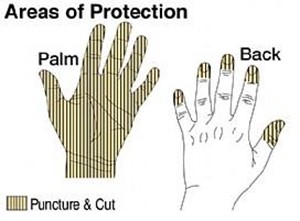How are TurtleSkin gloves different from other puncture and needlestick resistant gloves?
TurtleSkin gloves use a unique patented technology – an ultra-thin, tight-knit aramid weave – that is unparalleled by any other puncture resistant glove on the market. TurtleSkin are experts in technical weaving and use a patented process to achieve the tightest knit available.The gloves use a single layer of incredibly thin (about as thin as three sheets of paper) and flexible protective fabric, providing a high level of puncture protection and dexterity. Most other puncture resistant gloves rely on layering fabrics to protect, meaning they tend to be thicker and more cumbersome than TurtleSkins.
Are TurtleSkin gloves puncture proof?
No, TurtleSkin gloves are not 100% puncture proof – they are highly puncture resistant.They are designed to be comfortable and to allow the wearer full dexterity and tactile sensitivity. A completely puncture proof glove would not be practical to wear. TurtleSkins are capable of withstanding approximately 250 grams of pressure from a 28-gauge needle – the most common needle size.
Are TurtleSkin gloves cut proof?
As above, no safety glove can practically be completely impervious to cuts. TurtleSkins offer a balance of high-level cut resistance (Level 3 for the Alpha and level 2 for the Bravo) across the most at-risk areas of the hand.Do TurtleSkin gloves protect the entire hand from needles?
Different TurtleSkin styles provide different hand coverage. Some gloves protect the entire hand, while others only provide full protection to the palm, fingers and fingertips – the areas most at risk from needlestick injuries.Are there safety gloves that protect the fingertips?
Yes, TurtleSkin offers safety gloves designed to protect the fingertips.During many activities, the fingertips are often the most vulnerable to needlestick injuries. This is especially true in the waste and recycling industry or for police officers conducting search operations.
Most gloves don’t offer fingertip protection for one very simple reason – they can’t! Protective systems that rely on layering fabrics tend to be too thick to stretch over the fingertips. TurtleSkin gloves achieve puncture resistance through the tightness of their weave rather than the layering of fabrics.
Our patented puncture-resistant fabrics are uniquely thin – almost as thin as three sheets of paper. Because of this, it is easy to extend coverage over the fingertips and beyond the base of the fingernail.

Do TurtleSkin gloves protect against animal bites and scratches?
TurtleSkins are not designed specifically to protect against animal bites or claw scratches.The puncture resistance of our fabrics means that the gloves will provide protection against the skin being pierced by fangs or claws but won’t protect against the blunt trauma of an animal bite. While the teeth may not pierce the fabric, the bite will still hurt!
My TurtleSkin gloves feel slightly stiff, will they get softer?
Yes, the safety gloves will get softer and easier to wear the more they’re worn.Can I wash my TurtleSkin gloves?
Yes, your gloves are safe to wash – some models need to be washed by hand, while others are fine to put in a washing machine. Check the care guidance for your gloves for more information.Other safety gloves use a coated fabric for puncture protection, making them vulnerable to water. TurtleSkins achieve needle resistance with the tightness of their weave, meaning their integrity is unaffected when wet.
Are TurtleSkin safety gloves CE certified?
Yes, all TurleSkin gloves have gone through our rigorous testing process and carry CE certification.How do I properly dispose of needles and sharps?
A sharps bin is required to safely dispose of needles and sharps.Any used implements should immediately be put into the sharps bin. Nothing should ever be taken out of the bin, nor should the bin be filled above the recommended level. The bin needs to be disposed of every three months, even if it isn’t full.
Do not attempt to recap needles prior to disposal (this is a frequent cause of needlestick injuries).
Full bins should be disposed of using accredited medical waste companies or via your local council.
Needles and sharps should never be disposed of in any other way, including into bottles or cans. They should not be put into general waste or recycling.
What is aramid?
Aramid is the generic name for strong synthetic fibres that carry five times the tensile strength of steel while being relatively lightweight. Aramid has a distinctive yellow colour and is often used in advanced composite products that require high strength and low weight.What is a Safety Syringe?
A safety syringe is an injection syringe that has a built-in safety mechanism designed to prevent needlestick injuries. Usually, the mechanism either places a sheath over the needle or the needle retracts into the body of the syringe. The use of safety syringes has become more widespread as the focus on preventing needlestick injuries has increased.Do you use real turtle skin?
No! TurtleSkin loves turtles. Their shells are tough as anything, and so are TurtleSkin gloves and body armour.Most TurtleSkin gloves are made of fine aramid fibres, seven times stronger than steel. These fibres are joined with a tight weave that offers protection from needles and fine sharps. This combination of superior materials and weave is what makes TurtleSkin gloves unique.
Read our other blogs for more information on first aid or contact us for further advice and information on our products.
About the author:
Jo Stokes is a writer, marketer and trained first aider at First Aid Online.
Find out more about Jo.
By Jo Stokes
Explore more: Workplace first aid & safety

